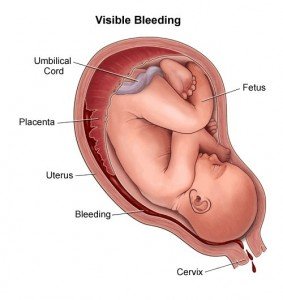
Vaginal bleeding can occur any time during the pregnancy from the moment the egg is fertilized to the termination of pregnancy. It is, however, important to know the difference between spotting and bleeding. The former pertains to a few drops of blood on the underwear every so often. But the amount is very little that it does not cover a panty liner. Bleeding, on the other hand, refers a heavier blood flow. Spotting may not always be a medical emergency but it should still be reported to the doctor.
Causes of Vaginal Bleeding during the Different Trimesters
There are several causes for vaginal bleeding in the first trimester and late-pregnancy stages. However, it is recognized that bleeding during the first trimester is more dangerous and can have more terrible consequences.
- First trimester bleeding
- Implantation bleeding: when the embryo implants itself on the uterine wall (normal and safe)
- Threatened miscarriage: baby is still in the uterus but outcome is unsure
- May occur alongside with infection and dehydration
- Completed miscarriage: the baby is lost (most common cause)
- Incomplete miscarriage: the baby is lost but miscarriage was not complete
- Blighted ovum: embryo developed in wrong location
- Missed abortion (intrauterine fetal demise): embryo dies inside the uterus
- Ectopic pregnancy: ovum implants outside the uterus, commonly in Fallopian tube (most dangerous)
- Molar pregnancy presence of abnormal tissue inside the uterus, may be cancerous
- Poscoital bleeding: after sexual intercourse (normal)
- Unrelated to pregnancy, such as injury to vaginal wall
- Late-pregnancy bleeding
- Placenta previa: partial or complete covering of the cervical opening by the placenta
- Placental abruption: premature separation of normal placental from uterine wall
- Uterine rupture: unusual splitting open of the uterus
- Fetal vessel rupture: blood vessels of the fetus attach to the membranes rather than the placenta
Symptoms of Vaginal Bleeding
Aside from the obvious bleeding from the vagina, several other symptoms usually accompany vaginal bleeding, which include:
- Color of blood
- Bright red blood: placenta previa
- Dark blood clots: placental abruption
- Contractions
- Abdominal cramping
- Dizziness or lightheaded
- Thirsty
*Always seek for medical advice if one experiences vaginal bleeding during pregnancy.
Management for Vaginal Bleeding
It is important to manage bleeding during pregnancy treatment. The
following steps are not meant to be substituted for medical advice or first aid training. Enroll in first aid courses to learn more on how to treat medical emergencies with pregnant women.
- Use a sanitary pad or panty liner to monitor the amount of bleeding and to give to the doctor for examination.
- Prevent any further bleeding. Do not insert anything into the vagina.
Seek medical advice for any type of vaginal bleeding during pregnancy.
